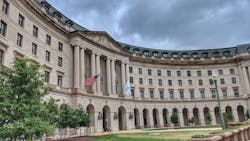Federal regulators bow to Supreme Court on Clean Water Act jurisdiction
The Biden administration has revised regulations on the jurisdiction of the Clean Water Act to conform to a recent Supreme Court ruling that narrowed the scope of the regulators’ authority. The revisions fell far short of what was needed, in the view of critics in the oil and gas industry and other industries.
The Environmental Protection Agency (EPA) and the US Army Corps of Engineers jointly published a final rule extensive updating the regulations Jan. 18 only to see parts of the rule outdated by the Supreme Court ruling in Sackett v. EPA (OGJ Online, May 25, 2023).
“We’ve moved quickly to finalize amendments to the definition of ‘waters of the United States’ to provide a clear path forward that adheres to the Supreme Court’s ruling,” said EPA Administrator Michael Regan in announcing the revisions Aug. 29.
The core change was to eliminate references to a “significant nexus” test when determining whether wetlands, lakes, ponds, or streams are sufficiently connected to rivers or marine waters as to fall under Clean Water Act regulation. Extensive permitting delays can hang on such a determination. The idea of “significant nexus” analyses was put forward in 2006 by a Supreme Court justice and has been controversial ever since.
By refraining from new efforts to define the jurisdiction of the act, EPA and the Corps of Engineers said their revisions could take effect immediately. They said no public comment periods were needed because the agencies were acting in obedience to a court decision rather than exercising agency discretion, and because they were not imposing new burdens on the regulated community.
‘New layer of confusion’
The agencies amended only a handful of paragraphs in their regulations, and that has drawn fire from the American Gas Association (AGA) and other industry groups who say it is an inadequate response to the court decision.
“The revised Waters of the U.S. (WOTUS) rule fails to comply with the Supreme Court’s recent ruling in Sackett v. EPA,” AGA said. “Rather than providing much-needed and long-awaited clarity on the definition of WOTUS, this rule adds a new layer of confusion to an already complex issue.”
Tim Parr, AGA deputy general counsel, offered additional explanation Aug. 30. He said the regulatory revisions got rid of “significant nexus” analyses but “did not provide clarity or guidance on how the EPA and the Corps will apply several other critical terms and concepts when determining jurisdiction under the Clean Water Act, namely what constitutes a ‘relatively permanent’ body of water or what constitutes a ‘continuous surface connection.’ How the agencies define and apply these terms will go a long way to determining whether certain waters are subject to the act's jurisdiction, or not.”
Similarly, the agencies decision to remove interstate wetlands from the regulatory text but not clarify the scope of which interstate waters are jurisdictional will probably result in more ambiguity moving forward, Parr said.
The Sackett decision “made clear the federal government only has authority over relatively permanent waterbodies,” said the National Association of Home Builders. “By failing to provide a definition of a ‘relatively permanent’ waterbody, the Biden administration set the stage for continued federal overreach, bureaucratic delays during the wetlands permitting process, and regulatory confusion.”
The Biden administration revised “only a small slice of the rule that was rejected by the Supreme Court,” lamented the American Farm Bureau Federation. Farmers—landowners who in many places allow drilling for oil and gas—worry about federal agency encroachment on their property rights through the Clean Water Act.
About the Author
Alan Kovski
Washington Correspondent
Alan Kovski worked as OGJ's Washington Correspondent from 2019 through 2023.
